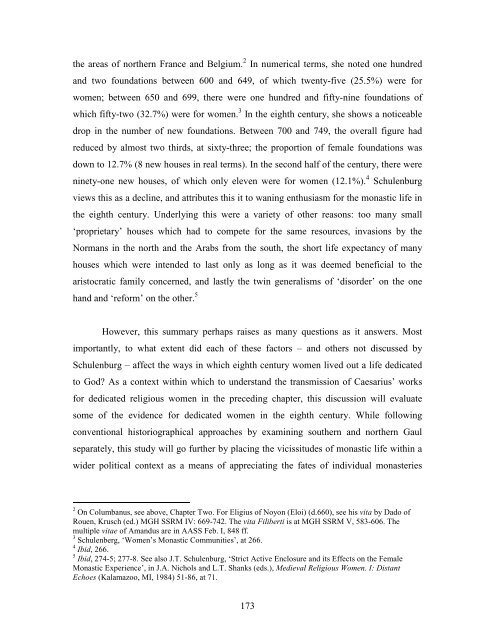Lindsay Rudge PhD Thesis - University of St Andrews
Lindsay Rudge PhD Thesis - University of St Andrews
Lindsay Rudge PhD Thesis - University of St Andrews
Create successful ePaper yourself
Turn your PDF publications into a flip-book with our unique Google optimized e-Paper software.
the areas <strong>of</strong> northern France and Belgium. 2 In numerical terms, she noted one hundred<br />
and two foundations between 600 and 649, <strong>of</strong> which twenty-five (25.5%) were for<br />
women; between 650 and 699, there were one hundred and fifty-nine foundations <strong>of</strong><br />
which fifty-two (32.7%) were for women. 3 In the eighth century, she shows a noticeable<br />
drop in the number <strong>of</strong> new foundations. Between 700 and 749, the overall figure had<br />
reduced by almost two thirds, at sixty-three; the proportion <strong>of</strong> female foundations was<br />
down to 12.7% (8 new houses in real terms). In the second half <strong>of</strong> the century, there were<br />
ninety-one new houses, <strong>of</strong> which only eleven were for women (12.1%). 4 Schulenburg<br />
views this as a decline, and attributes this it to waning enthusiasm for the monastic life in<br />
the eighth century. Underlying this were a variety <strong>of</strong> other reasons: too many small<br />
‘proprietary’ houses which had to compete for the same resources, invasions by the<br />
Normans in the north and the Arabs from the south, the short life expectancy <strong>of</strong> many<br />
houses which were intended to last only as long as it was deemed beneficial to the<br />
aristocratic family concerned, and lastly the twin generalisms <strong>of</strong> ‘disorder’ on the one<br />
hand and ‘reform’ on the other. 5<br />
However, this summary perhaps raises as many questions as it answers. Most<br />
importantly, to what extent did each <strong>of</strong> these factors – and others not discussed by<br />
Schulenburg – affect the ways in which eighth century women lived out a life dedicated<br />
to God? As a context within which to understand the transmission <strong>of</strong> Caesarius’ works<br />
for dedicated religious women in the preceding chapter, this discussion will evaluate<br />
some <strong>of</strong> the evidence for dedicated women in the eighth century. While following<br />
conventional historiographical approaches by examining southern and northern Gaul<br />
separately, this study will go further by placing the vicissitudes <strong>of</strong> monastic life within a<br />
wider political context as a means <strong>of</strong> appreciating the fates <strong>of</strong> individual monasteries<br />
2<br />
On Columbanus, see above, Chapter Two. For Eligius <strong>of</strong> Noyon (Eloi) (d.660), see his vita by Dado <strong>of</strong><br />
Rouen, Krusch (ed.) MGH SSRM IV: 669-742. The vita Filiberti is at MGH SSRM V, 583-606. The<br />
multiple vitae <strong>of</strong> Amandus are in AASS Feb. I, 848 ff.<br />
3<br />
Schulenberg, ‘Women’s Monastic Communities’, at 266.<br />
4<br />
Ibid, 266.<br />
5<br />
Ibid, 274-5; 277-8. See also J.T. Schulenburg, ‘<strong>St</strong>rict Active Enclosure and its Effects on the Female<br />
Monastic Experience’, in J.A. Nichols and L.T. Shanks (eds.), Medieval Religious Women. I: Distant<br />
Echoes (Kalamazoo, MI, 1984) 51-86, at 71.<br />
173

















